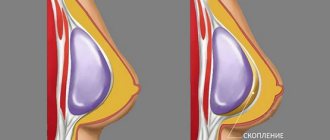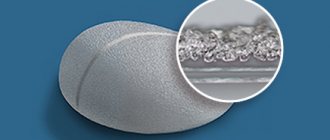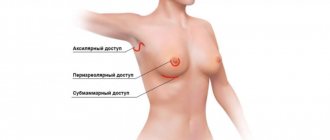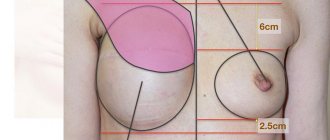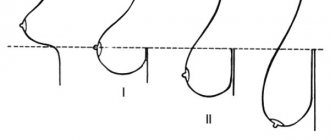Any correction of the mammary glands entails changes in the body, most of which go away over time. During the rehabilitation period, swelling and thickening of the breast are characteristic. There is no need to worry about this, because this is a natural manifestation of the body’s recovery after surgery. When the breast becomes soft after breast augmentation, the effects of surgery disappear almost completely. The rehabilitation period depends on the characteristics of the body and the professionalism of the doctor.
Mammoplasty: rehabilitation by day
The first thing you need to understand: although plastic surgery refers to aesthetic medicine, it is nevertheless surgery. Therefore, mammoplasty should be treated not only as an operation that helps make the breasts beautiful and the figure more harmonious, but also as a serious intervention. Accordingly, the day-to-day recovery after mammoplasty will be similar to recovery after a “traditional” surgical operation.
1 day.
Upon completion of the operation, the patient is transferred to the recovery room. There her condition is monitored by an anesthesiologist. After 1–1.5 hours, the patient is transferred to a regular ward, where she can rest after the operation, but will be under the supervision of medical personnel. At the same time, drug treatment begins. It includes painkillers that help eliminate discomfort in the operated area. Antibacterial drugs can also be used, the purpose of which is to prevent possible complications. Even in the operating room, after sutures are applied and processed, the patient is put on compression garments pre-selected to size. It provides reliable fixation of the breast and prevents its displacement. You need to wear it constantly for a month, even during sleep, taking it off only for hygiene procedures.
1–4 days.
Hospital stay is usually limited to one day. Before discharge, the patient is given a memo that contains all the recommendations for the correct completion of the recovery period. If this is necessary, the doctor conducts an additional consultation. For 3-4 days after mammoplasty, any physical activity should be avoided - it is advisable to spend this time observing maximum rest. More or less pronounced pain and discomfort are felt in the mammary glands, which are natural for any surgical intervention. But these symptoms are alleviated and even completely eliminated with the help of medications prescribed by a doctor. In addition, there may be a slight increase in body temperature, usually between 37.0–37.5 °C.
3–4 days.
During this period, swelling of the breast tissue becomes most noticeable. This is a natural reaction of the body and should not cause concern. In addition, you should not be afraid of the “strange” appearance of the breasts - the shape and size of the mammary glands can be changed by swelling to a greater or lesser extent, but in this period it is too early to draw conclusions about the results of the operation. Swelling may slightly increase discomfort as it makes it difficult to move your arms. This symptom may persist for several weeks, but gradually its severity will decrease. It is important to know that swelling can intensify during sports, at high ambient temperatures, etc. Therefore, it is necessary to carefully follow recommendations for limiting physical activity, avoid visiting the sauna, avoid being in direct sunlight, etc.
5–6 days.
At this stage, the pain hardly bothers you or bothers you very little, which does not require taking painkillers. During this period, you can gradually return to your normal life. But the key word is still “gradually.” For another 4-5 weeks, you need to exclude any loads that involve the muscles of the upper shoulder girdle and chest. Heavy lifting, active sports and similar types of physical activity should not be allowed. And the “sleeping on your back” rule still applies - it will be relevant for 2-3 weeks after the operation.
1 Week.
Seven days after mammoplasty, the time for the first visit to the doctor. There will be four in total, but the first visit is the most important and should not be missed under any circumstances. During the consultation, the surgeon will assess the degree of healing of the sutures, the position of the endoprostheses and other criteria by which a conclusion can be made about the quality of tissue restoration. A conversation is also held with the patient, during which the doctor can adjust or discontinue medication treatment, as well as give additional recommendations necessary in a particular case.
2 weeks.
At this stage, the patient has already become accustomed to the “new” breast, the pain has disappeared, and compliance with the restrictions recommended during the recovery period no longer causes difficulties. Fitness classes, visiting the pool, solarium and sauna are still prohibited, but to maintain physical fitness you can take walks without any restrictions.
1 month.
The next examination by a surgeon is carried out in order to both assess the progress of recovery and adjust recommendations. So, if the patient has followed all the rules for undergoing rehabilitation and healing is progressing successfully, the doctor may allow you to remove the compression garment while sleeping or remove other restrictions. But it is important to understand: this depends on the characteristics of the mammoplasty performed - for example, with a significant breast enlargement, restrictions may last longer than with a breast reduction or breast lift.
2 months.
By this time, it is already possible to draw the first conclusions about the results of the operation. The swelling completely disappears or decreases to almost imperceptible, the discomfort is no longer a concern, and at the next visit to the surgeon the patient can receive permission to play sports. Of course, subject to moderation and gradualism. From this period onwards, life almost completely returns to normal, with very few exceptions. It is still necessary to avoid stress on the upper shoulder girdle and chest muscles, thermal procedures (visiting a bathhouse, sauna, taking a hot bath, etc.) and avoid mechanical impact on the tissue of the mammary glands - massage, rubbing the chest with a washcloth and similar actions will still be prohibited a few months.
POPULAR QUESTIONS ABOUT MAMMOPlasty
Why shouldn't you be afraid of mammoplasty?
Many girls dream of changing the shape of their breasts, but fears do not allow them to move forward. 1. Is it safe? Yes, it's safe. In modern plastic surgery, the quality of silicone implants is of paramount importance. Patient safety comes first. 2. Fear of complications after. Mammoplasty is one of the most technically sophisticated operations. Complications are extremely rare and are mainly associated with the individual characteristics of the patient’s body. In any case, there is no need to be afraid. You need to follow the rehabilitation recommendations and everything will be fine. 3. Recovery after surgery. Usually, after reading on the Internet about how unbearably painful it is to go through the rehabilitation period, patients begin to panic. Firstly, do not trust everything that is written on the Internet, but rather listen to your surgeon. Secondly, all painful sensations are relieved by analgesics, and after 2 weeks you can return to your normal life. Preoperative examination: why and who needs it?
Of course, the operation itself is an important process. But before it, a very important stage is necessary - a preoperative examination, which is necessary for: 1) your surgeon. Surgery is a stress on the body. Therefore, a plastic surgeon needs to not only study the patient’s external features and find out his aesthetic preferences, but also assess the general condition of the body. ⠀ 2) Your anesthesiologist. The anesthesiologist, having received the data from the preoperative examination, will be able to prepare you as adequately as possible for the operation ⠀ 3) You. For your own peace of mind. ⠀ The exact list of examinations can be determined only after consultation with a doctor. In any case, remember: the doctor acts solely in the interests of your beauty and safety! The next block of questions related to pregnancy:
— When is it better to plan a pregnancy: before or after mammoplasty? If you plan to become a mother in the next year, then breast correction is recommended after the birth of the child. A minimum of 6 months must pass between breast augmentation surgery and pregnancy for the rehabilitation process after surgery to be successful. ⠀ — How long after the birth of a child can mammoplasty be done? You need to plan breast correction after birth for a child six months later if you have given up breastfeeding. If you were breastfeeding, then breast correction is allowed 6 months after the end of the lactation period. ⠀ — How does the lactation process occur in a woman who has enlarged her breasts with implants? Just like the woman who did not resort to any surgical interventions. The implants do not affect the milk ducts in any way, so they do not have the slightest effect on them. The presence or absence of silicone in the breast does not affect milk production. ⠀ — How will pregnancy and subsequent childbirth affect the appearance of breasts with implants? During pregnancy and breastfeeding, a woman's breasts undergo changes - they become larger. How? How much? Depends primarily on your genetics and personality. This process cannot be controlled or influenced in any way. Breast enlargement and swelling during pregnancy and then in the postpartum period occur even when you have implants installed. ⠀ — Do you need to replace implants after the birth of a child? Need not. Implants do not have an expiration date, so you will not need to replace implants after birth and breastfeeding. Questions about breast lift: ⠀ - If you just do a breast lift without implants, will it decrease significantly in size? Do not confuse breast lift - mastopexy - with breast reduction - reduction mammoplasty. With a breast lift without implants, the breasts will not decrease in size much, they will simply become “collected.” ⠀ — If you do a lift with implants, your breasts will sag 100% again, but not without implants? No. The truth is that loss of tone can occur after both a regular lift and an implant lift. Implants simply allow you to make the breast shape more rounded, add the missing volume and fill the upper pole a little more. ⠀ But here are the real reasons that can affect the result and breast ptosis: - Quality of skin and connective tissue - Strong weight fluctuations - Lack of skin care - Wrong lifestyle - Genetic predisposition of the skin to stretching - Pregnancy - Hormonal surge It is also important what breast size after surgery. The larger the breast volume, the more care and support in the form of tops/bras is needed. How long will the swelling last after surgery and how long should I wear compression garments?
Swelling after surgery is a reaction of the body that cannot be avoided, this also applies to mammoplasty. Every patient has to deal with breast swelling after mammoplasty, which makes it impossible to immediately assess the result of the operation. You have to wait for the swelling to subside and the breasts to become of a constant size. ⠀ Breast swelling after surgery occurs due to tissue damage, while the breasts become dense and change size and shape. Swelling becomes most noticeable by 3-4 days after surgery. Most often, swelling persists for 3-4 weeks, but in some women swelling persists for up to 2 months. ⠀ How to reduce swelling after mammoplasty? • Compression bra - thanks to the massage effect, it accelerates the removal of excess fluid in the chest area. • Avoid physical activity. But you don’t need to lie down all the time. In a horizontal position, the swelling is more difficult to subside. • Limiting water consumption at night and excessive salt intake. How long to wear compression garments after surgery? The breast after mammoplasty should be fixed. This is the main task for underwear - to create compression. What are the functions of compression garments? ⠀ - Contains swelling - Forms the correct breast shape - Does not allow the implant to go down, go up or move in different directions. — Helps improve blood circulation and accelerate the healing process. — Prevents tension and stretching of seams. - Compression reduces pain and discomfort ⠀ - Helps the spine cope and adapt to the new load. When will it be possible to take off my underwear? The answer is purely individual. On average, the optimal period is 4 weeks of constant wearing of underwear. Another common question: can implants “fail to take root”? ⠀ Implants consist of material that is biologically compatible with our body. Despite this, isolated cases of rejection still occur. But considering how many operations are performed, these numbers are very small. ⠀ Why could something go wrong? ⠀ ▪Individual reactions, healing features, the presence of chronic inflammatory and other infectious processes. ▪Another option when something goes wrong is when the patient does not follow the surgeon’s recommendations. For example, he doesn’t care about his health. They are actively involved in sports within a week, arguing that they feel great. Or they sleep on their stomach after a month, although there is a limit for at least six months. ▪In addition to such situations, of course, it is important that there are no blows to the operated area or injuries. ⠀ Conclusion: there is almost no implant rejection. And if you follow all the doctor’s instructions, the risks of complications are reduced to a minimum. These were some of the frequently asked questions among patients about mammoplasty. The main thing you can take away from this is that you should not be afraid of this operation. All questions will be studied in detail during consultation with the surgeon.
What to pay attention to
Breast restoration after mammoplasty largely depends on the individual characteristics of the patient’s body, metabolic rate, general health and other factors. Therefore, the periods listed above can shift down or up, and the rehabilitation will proceed normally. But in some cases, you should contact your doctor without waiting for your scheduled consultation date.
Contact your surgeon if you experience any of the following symptoms:
- increased body temperature, which persists 7–10 days after surgery;
- discharge from sutures;
- significant changes in the scars (severe redness, their bulge, etc.);
- marked deterioration in health, lack of recovery 2–3 weeks after surgery.
In most cases, such symptoms indicate an incorrect recovery period or are associated with the individual characteristics of the situation. But as a precaution, you should contact your doctor and get specialist advice.
Why do breasts become hard after breast augmentation?
Mammoplasty is a complex process that causes stress to the body. If you follow the surgeon’s recommendations, you can avoid complications and negative consequences.
The following are considered normal reactions in the postoperative period:
- Pain, burning, tingling;
- Swelling, hematomas, swollen tissues;
- Exacerbation of skin sensitivity;
- Dull sensation in the nipples;
- Muscle tightening and tension.
During the operation, the doctor makes incisions in certain places, which naturally involves microdamage to blood vessels and tissues. Fluid accumulates in them, which serves as a protective material against infections and inflammation, and also provokes the formation of edema. They are the main reason for the hardness of the mammary glands. Swollen breasts add stress to the spine, so one of the main requirements after correction is wearing compression garments.
The location of pain or swelling may vary, but this is normal. With the correct recovery schedule, the consequences of surgery disappear within 2-4 weeks. Long-term preservation of hematomas and lumps is caused by non-compliance with the regimen, violation of the specialist’s instructions, and early physical activity. Implants tend to sit high for the first few weeks, after which they lower and take a permanent position.
When do breasts become soft after breast augmentation?
During the normal course of the operation without complications, a decrease in the hardness of the mammary glands occurs after 2-3 months.
The type and composition of prostheses is of great importance; they are distinguished:
- Silicone. More dense in structure, there is a special viscous gel inside that can retain its shape even if the shell is damaged;
- Saline. They are relatively soft due to the saline solution inside. The liquid creates a suitable shape and retains it longer.
With silicone implants, the breasts become soft after enlargement after about 3-4 months, with saline implants after 2-3 months. A more precise time frame can be determined by a plastic surgeon.
You can make your figure perfect today. It is enough to consult a qualified doctor.
